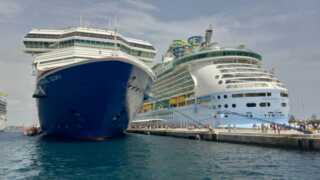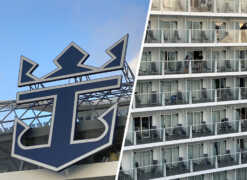For many cruisers, the primary reason they book specific sailings is because of the exciting destinations they will get to visit. But what happens when a port of call gets cancelled?
These are the most common reasons why a port call may get scrapped, as well as what a cancellation means for your cruise vacation and for your wallet.
In This Article:
Why Ports of Call Can Be Cancelled
The cruise lines never want to disappoint guests by removing a destination they may have been looking forward to, but sometimes external factors leave them with no other options.
Usually, cancellations are the result of matters of safety, port availability, unexpected maintenance needs, and/or Mother Nature’s refusal to cooperate.
Safety
The safety of the vessel and all guests and crew members onboard is always the top priority for the cruise lines.
With this in mind, ports of call that could potentially put guests in danger may be removed from itineraries, if only out of an abundance of caution.
Royal Caribbean’s Labadee Destination (Photo Credit: Darryl Brooks / Shutterstock)
For example, Royal Caribbean has famously cancelled more than six months of visits to its private resort at Labadee, Haiti, due to ongoing unrest in Haiti’s capital – which is more than 100 miles away.
Similarly, the ongoing tensions in the Red Sea have forced many cruise ships to steer clear of the region entirely.
Poor Weather
Especially during hurricane season, stormy weather may pop up that makes it unsafe to visit certain cruise ports.
While cruise ships are well equipped to handle rough seas, docking during windy conditions and heavy rain can be dangerous because it increases the risk of collision with port infrastructure or other ships that may be in the harbor.
Royal Caribbean Cruise Ships in Developing Storm (Photo Copyright: Cruise Hive)
Tendering during poor weather conditions is even more dangerous, as guests must be able to safely transfer to and from smaller vessels (which are much more impacted by wind and big swells than the larger cruise ship).
Natural Disasters
Less commonly, a natural disaster like an earthquake or landslide may force a cruise ship to alter course.
These unfortunate events may cause damage to port infrastructure, making docking impossible.
Landslide in Port Vila following 7.3-magnitude earthquake. (Photo Credit: Dan McGarry)
Alternatively, damage within the town or city itself may make it impractical, or even dangerous, to welcome an influx of cruise guests.
For example, a massive 7.3 earthquake in Vanuatu in December of 2024 left behind a sea of destruction, forcing Port Vila to cease cruising operations for eight long months.
Unexpected Maintenance and Repairs
This is a category that can apply to both cruise ports and to cruise ships.
The cruise ports have to maintain their infrastructure to make sure everything remains safe and functional, and may schedule routine maintenance after a cruise line has already released its itineraries for the years ahead, which can lead to scheduling conflicts.
On the other hand, there are situations where a pier or other infrastructure is damaged unexpectedly by a cruise ship or weather and has to turn vessels away until repairs can be made.
San Juan’s Pier 3, for example, was out of commission from November of 2024 until July of 2025 after MSC Cruises’ MSC Meraviglia accidentally damaged its dolphin mooring structure.
Pier 3 in San Juan (Photo Credit: Nenad Basic)
As this was the only pier in San Juan that could accommodate larger mega-ships, such as Royal Caribbean’s Oasis-class ships, many port calls had to be cancelled during the months-long closure.
On the cruise ship side of things, unexpected technical problems, such as propulsion issues, may limit the vessel’s speed.
Speed limitations may make it impossible to reach a planned destination timely, which subsequently leads to a cancellation.
Alternatively, a cruise ship that experiences an unexpected issue may remain stuck at a previous destination, and will have to cancel port calls that come later to allow time for repairs to be completed.
Port Congestion & Pier Reassignments
The cruise lines often plan and release itineraries years in advance, and things can sometimes change as embarkation day approaches.
Sometimes, this results in overbookings, excessive port traffic, or pier reassignments that makes it unsafe or impractical for a cruise ship to make its planned visit.
Port Accessibility Challenges
Sometimes, there is simply an obstacle in the way that makes it impossible for the cruise ship to reach the dock.
For example, a build up of sediment can make water levels too shallow to navigate a certain area. This is what barred Princess Cruises’ Island Princess from visiting Puerto Chiapas, Mexico, in September 2025.
Carnival Pride Sailing Under the Francis Scott Key Bridge (Photo Credit: Larry Syverson / Flickr)
When the Francis Scott Key Bridge collapsed in Baltimore in March of 2024, several cruise ships were rerouted because they were not able to navigate around the damage.
Less commonly, environmental protestors in Europe have successfully prevented some cruise ships from docking by blocking their path with smaller vessels, or even people.
Changes to the Financial Situation
Some port of call cancellations can also be financially motivated. If a port has recently increased taxes and fees on cruise ships, the cruise line may opt to skip the port.
The other two options are usually not very appealing, especially if the fees were increased by a significant amount. The alternatives are for the cruise line to eat the financial loss or pass the fees onto their passengers.
Read Also: How to Save Money on a Cruise: Cash-Savvy Spending Tips
It’s also worth noting that cruise lines are allowed to charge booked passengers for new port fees that go into effect after they reserved their sailing, even after they’ve already paid in full.
Onboard Emergencies
While the goal is for everyone onboard to stay safe, happy, and healthy for the duration of their sailing, sometimes medical emergencies occur and a guest will need to be evacuated to receive urgent treatment.
This could mean that the cruise ship has to deviate from its course to drop the guest off at the nearest port.
Alternatively, the ship may need to pause or relocate to rendezvous with first responders for an airlift at sea.
Overboard Icon of the Seas Crew Member
And in rare man overboard situations, the cruise line is required to stop and search for the missing person until they are found or until authorities arrive to take over search and rescue efforts.
Depending on how long the cruise ship is delayed or how far out of its way the vessel must travel, port calls may be delayed or cancelled.
Illness Outbreaks
In extreme situations, a port may turn a cruise ship away if there is an illness outbreak onboard that poses an imminent threat to public health.
Outbreaks are monitored on a case-by-case basis, and more often than not, passengers are still allowed to disembark and explore (with perhaps some extra precautions in place).
When Do Cruise Lines Decide to Cancel?
Cancelling a port call is not a decision that the cruise ports make lightly. It comes with a lot of thought and impacted guests are notified as soon as possible.
If a cruise line is made aware of factors like port accessibility or port congestion in advance, they may notify guests of the change, potentially weeks to months ahead of their voyage.
Navigation Systems (Photo Credit: Alexey Seafarer / Shutterstock)
This gives cruisers the opportunity to adjust shore excursions or potentially change their plans if the new itinerary isn’t satisfactory.
But many times, the decision to cancel or replace a port call isn’t made until the very last minute after every possible option to still visit is explored.
In these cases, passengers may not learn of the change until they are onboard and just a few hours away from when they were due to arrive at the destination.
They will usually be updated via overhead announcements and/or by letters that are delivered to their cruise cabins.
What Alternatives are Possible?
Once a cruise line has made the decision to cancel a port call, they have three alternatives to explore.
The first option, which is usually the most desirable, is to replace the scrapped destination with a new port of call.
But in order for this to work, the cruise line must find another desirable port that has availability and fits in with the rest of the itinerary.
Radiance of the Seas in Alaska (Photo Credit: Just dance)
The next option is to simply spend another day at sea, allowing guests more time to explore the ship and take advantage of the entertainment and amenities onboard.
In rare cases, the cruise line may opt to shorten the sailing, but this would only happen if there is something else going on (i.e., emergency maintenance or weather related) that would make it unsafe to complete the full voyage.
What Happens to Port Fees?
Port fees are fees and taxes that are levied on cruise ship passengers when they visit ports of call during their sailing.
The cruise lines typically collect port fees as part of the cruise fare, and then pay them on behalf of their passengers.
Carnival Ships in Cozumel (Photo Credit: B.D.S. Media)
In the event that a port call gets cancelled and isn’t replaced with a new stop, port fees are typically refunded automatically, either in the form of an onboard credit or to guests’ original form of payment.
If the cancelled port is replaced with a new destination, guests usually are not charged additional port fees. Their original payment would roll over to the new port and any excess would be refunded.
What Happens to Shore Excursions?
If a cancellation occurs, shore excursions for that destination that were booked through the cruise line will be automatically cancelled and refunded.
If the port call has been replaced with a different destination, the cruise line will usually roll out new tours for passengers to book.
Cruise Ship Excursions (Photo Credit: Ceri Breeze)
However, the cruise lines are not responsible for land tours that are booked through independent vendors. Guests would be subject to the outside company’s cancellation and refund policies.
Are Guests Entitled to Compensation?
When guests book a cruise, they agree to a cruise ship contract.
One of the standard terms in these contracts is that the cruise lines have a right to change the itinerary as circumstances require without providing compensation to passengers.
Cruise Passengers on Royal Caribbean Ship (Photo Credit: steve estvanik)
However, many cruise lines may occasionally offer some compensation, such as onboard credits or a future cruise credit, as a gesture of goodwill.
Final Thoughts: How to Respond to Itinerary Changes
While the cruise lines always do their best to honor and maintain the original itineraries, it’s important to keep in mind that no itinerary is guaranteed.
While an itinerary change can be disappointing, there is no reason that the cruise vacation can’t still be every bit as fun and memorable as guests hoped for and expected.
If you ever find yourself in this situation, do your best to roll with the punches and find the joy in the opportunities that are available to you during your cruise.
Appeared first on: Cruisehive.com




